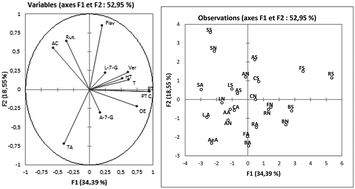Phenolic profiles of eight olive cultivars from Algeria: effect of Bactrocera oleae attack
Abstract
Olive fly (Bactrocera oleae R.) is the most harmful pest of olive trees (O. europaea) affecting their fruit development and oil production. Olive fruits have characteristic phenolic compounds, important for plant defense against pathogens and insects, and with many biological activities, they contribute to the high value of this crop. In this study, olives from 8 cultivars (Abani, Aellah, Blanquette de Guelma, Chemlal, Ferkani, Limli, Rougette de Mitidja and Souidi) with different degrees of fly infestation (0%, not attacked; 100%, all attacked; and real attack %) and different maturation indices were sampled and analysed. Qualitative and quantitative analyses of phenolic profiles were performed by colorimetric methodologies and RP-HPLC-DAD. Verbascoside, tyrosol and hydroxytyrosol were the compounds that were most adversely affected by B. oleae infestation. Principal component analysis and hierarchical cluster analysis highlighted different groups, showing different behaviours of olive cultivars to the attack. The results show that phenolic compounds displayed sharp qualitative and quantitative differences among the cultivars. The fly attack was significantly correlated with the weight of the fruits, but not with the phenolic compounds.



 Please wait while we load your content...
Please wait while we load your content...